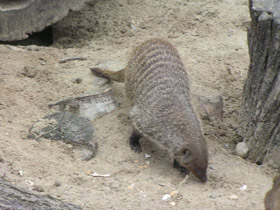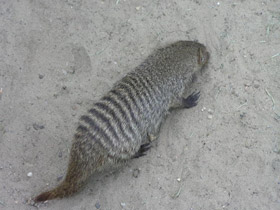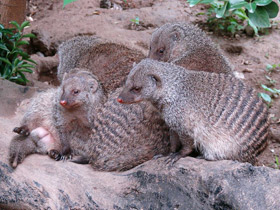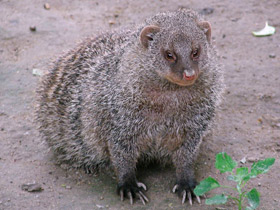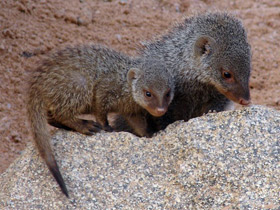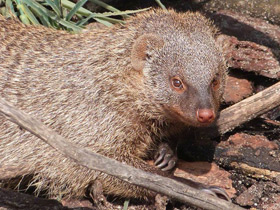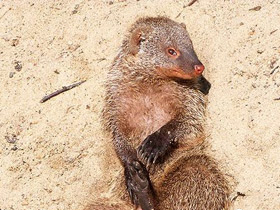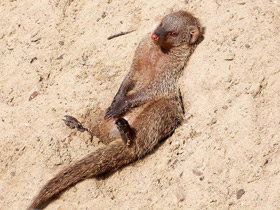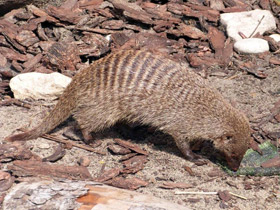The banded mongoose (Mungos mungo)
The banded mongoose (Mungos mungo) is a mongoose species native from the Sahel to Southern Africa. It lives in savannas, open forests and grasslands and feeds primarily on beetles and millipedes. Mongooses use various types of dens for shelter including termite mounds. While most mongoose species live solitary lives, the banded mongoose live in colonies with a complex social structure.
Description
The striped mongoose (Mungos mungo) is a species of carnivorous mammal.
Mungos mungo owes its name to the pattern of 10-15 dark transverse stripes on its back, running from the shoulders to the tail. It reaches a body length of 30-45 cm and weighs between 1.5 and 2.25 kg. It has a small head with a short, pointed muzzle and small, rounded ears. The mung mongrel is covered with stiff hair, which shortens on the head and lengthens towards the tail, reaching a length of 45 mm in some specimens.
Each hair on the back of the mung back is light at the base and has two broad dark stripes in the centre and a narrow dark tip.
These animals have 5 toes on the front legs and 4 on the hind legs, with the front toe small but with a long 8 mm claw used for digging.
Habitat and nutrition
Widespread in eastern, southern and central Africa, the Mungos mungo inhabits savannahs, light forests and dense thickets, usually near water. They are active mainly in the morning and evening, and spend the rest of the day digging. These predators feed on small reptiles, molluscs, eggs and chicks of small birds, berries and fruits. However, they feed mainly on various arthropods, primarily beetles, millipedes and ants (up to 200 in a litter).
In search of food they usually move 2-3 km away, but this can increase to 10 km in open terrain. Mung Mungos scour the ground in a zig-zag pattern that allows them to find food up to once a minute.
Although mung mung live in groups, they are often solitary in their search for food. They communicate with each other by emitting a low growl every few seconds. While foraging, they sniff the ground, rake up fallen leaves and dig with their forelegs. In doing so, they rarely dig more than a few centimetres deep into the ground. Before eating a millipede, frog or other animal with poisonous secretions, the animals first roll them along the ground to clean the poison from them. Mungos mung beetle eggs or hard shells by throwing them on stones or other hard surfaces.
Social behaviour
Unlike many other members of the family, Mungo mung are grouped in groups with a complex social structure. The group usually consists of 7-40 animals (15-20 on average), but may have up to 70 animals near human dwellings or other good food sources. All members sleep together.
During the day, cubs less than a month old stay in a shelter where a few adults (usually males) guard them in turn, while the rest of the adults hunt. They change shelters with everyone else, but this does not happen often, about 2-3 times during their first month of life. Members of a group distinguish "their own" from "strangers" by their scent, and regularly mark each other with secretions from their anal glands, which is especially active when a group member has been absent for a long time and has returned to the group. They also mark many objects found in the group's territory, such as large rocks and trees.
Mung Mungos' attitudes are extremely aggressive: they actively defend the borders of their territories against neighbouring groups, and in inter-group fights mongooses may injure or even kill each other. When members of rival groups become aware of each other's presence, they stand up on their hind legs and give a warning shriek to the rest of their group. If one group greatly outnumbers the other, the smaller one may flee and the larger one will chase it.
There is no clear social hierarchy within the group and the level of aggression in the group is usually low. When the number of females in the group is too high, the larger females may be chased out of the group by other females or even by the males.
Reproduction
Unlike most mung mung species, where only dominant females breed, in the striped group several females can breed at the same time (which is unusual for most raptors). Not only that, but female mung mongrels living in the same group have synchronised birthing cycles. The synchronised births of several females of different social rank are supposed to be an adaptation to avoid infanticide (killing of cubs) by other females and dominant males, as in this situation they cannot distinguish their cubs from strangers. Therefore, several females in a group raise their pups together.
The gestation period of Mungos mungo lasts about 60 days, after which the female gives birth to 2 to 4 pups weighing between 20 and 50 grams. At 4 weeks of age, they begin to make brief forays outside the shelter to forage for food. At 5 weeks of age, the cubs forage for food in the morning, along with all the adults. They become independent after about 3 months. The adults actively interact with the pups by watching, playing and caring for them.
Mung Mungos are easily tamed and very intelligent. Locals often keep these fearless, tame and extremely intelligent animals as pets.
Taxonomy
Viverra mungo was the scientific name proposed by Johann Friedrich Gmelin in 1788 for a mongoose that was described earlier by several other naturalists. In the 19th and 20th centuries, several naturalists described mongoose specimens and proposed subspecies:
- Adail banded mongoose, Mungos mungo adailensis (Heuglin, 1861);
- Boror banded mongoose, Mungos mungo bororensis (Roberts, 1929);
- North-west banded mongoose, Mungos mungo caurinus (Thomas, 1926);
- East African banded mongoose, Mungos mungo colonus (Heller, 1911);
- Mungos mungo fasciatus (Desmarest, 1823);
- Namibia banded mongoose, Mungos mungo grisonax (Thomas, 1926);
- Schwarz's banded mongoose, Mungos mungo mandjarum (Schwarz, 1915);
- Mungos mungo marcrurus (Thomas, 1907);
- Botswana banded mongoose, Mungos mungo ngamiensis (Roberts, 1932);
- Mungos mungo pallidipes (Roberts, 1929);
- Mungos mungo rossi (Roberts, 1929);
- Mungos mungo senescens (Thomas & Wroughton, 1907);
- Mungos mungo somalicus (Thomas, 1895);
- Talbot's banded mongoose, Mungos mungo talboti (Thomas & Wroughton, 1907);
- Mungos mungo zebra (Rüppell, 1835);
- Mungos mungo zebroides (Lönnberg, 1908).
Interspecies relations
Banded mongooses have been observed removing ticks, fleas, and other parasites from warthogs in Kenya and Uganda.

















